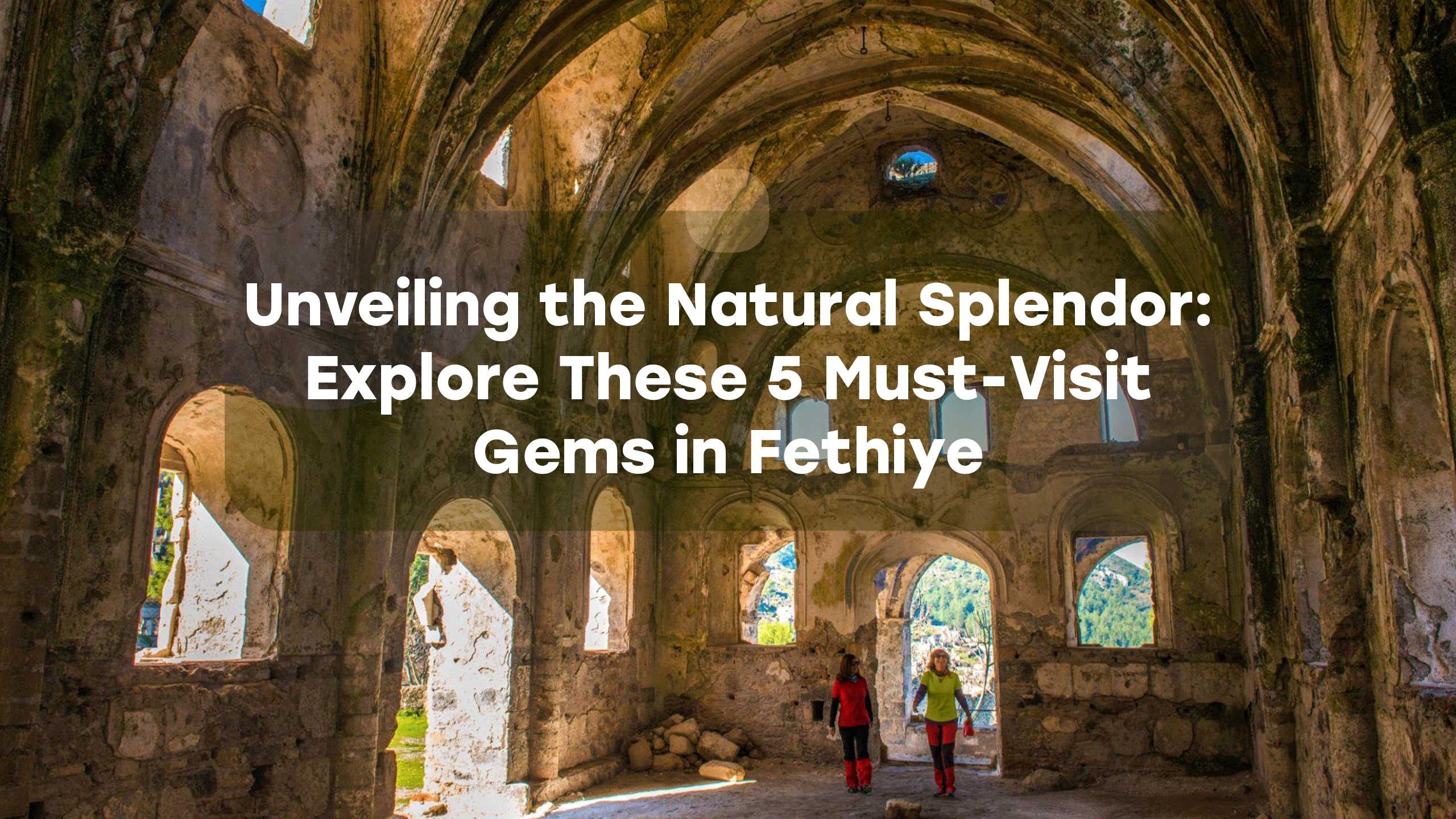Unveiling Fethiye's Historical Treasures: Exploring Ancient Sites
Fethiye, a captivating destination on Turkey's Mediterranean coast, is a treasure trove of historical wonders and ancient sites. Immerse yourself in the fascinating history of this region as you explore its archaeological heritage and uncover the hidden gems it holds. From the mystical rock tombs of the Lycian city of Kaunos to the grandeur of Fethiye's Roman Theater and the UNESCO World Heritage Site of Xanthos , Fethiye beckons travelers with its captivating historical treasures and cultural heritage.
Journey into the Ancient Lycian City: The Enigmatic Rock Tombs of Kaunos
A must-visit in Fethiye, the Lycian city of Kaunos is famous for its enigmatic rock tombs that serve as a testament to its historical treasures. Carved into the cliffs, these remarkable tombs offer a glimpse into the ancient Lycian civilization. Marvel at the intricate details and craftsmanship of the rock tombs as you ponder the mysteries they hold. The rock tombs of Kaunos are a captivating representation of Fethiye's rich history and its archaeological heritage. The Rock Tombs of Kaunos were built in the 4th and 3rd centuries BC, and they are a UNESCO World Heritage Site. The tombs are the final resting places of the wealthy and powerful people of Kaunos, a city that was located on the site of modern-day Dalyan. The tombs are decorated with elaborate reliefs that depict scenes from Greek mythology and the lives of the deceased. The most famous of the Rock Tombs of Kaunos is the tomb of Payava, a wealthy merchant who lived in the 4th century BC. The tomb is decorated with reliefs that depict Payava's life, including scenes of him hunting, feasting, and sailing. The Rock Tombs of Kaunos are a fascinating example of ancient Lycian funerary architecture. They are a popular tourist destination, and they offer a unique glimpse into the lives of the wealthy and powerful people of Kaunos.
Here are some additional facts about the Rock Tombs of Kaunos:
The tombs are carved into the cliffs of the Dalyan River, which is a popular tourist destination for its mud baths and dolphin-watching tours. The tombs are decorated with reliefs that depict scenes from Greek mythology, such as the battle between Theseus and the Minotaur. The tombs are also decorated with reliefs that depict the lives of the deceased, such as scenes of them hunting, feasting, and sailing. The Rock Tombs of Kaunos are a UNESCO World Heritage Site, which means that they are considered to be of outstanding universal value.
Exploring the Ancient City and Its Cultural Heritage: Telmessos
Telmessos was founded in the 7th century BC by the Lycians, an ancient people who inhabited the region. Telmessos was a prosperous city during the Hellenistic period (323-31 BC). The city was home to a large number of wealthy merchants and traders, and it was a major center of commerce. Telmessos was also a popular tourist destination, and it was known for its beautiful beaches and its mild climate. In the 1st century AD, Telmessos was renamed Anastasiopolis in honor of the Roman emperor Anastasius I. The city continued to prosper during the Roman and Byzantine periods, and it was an important center of Christianity. Telmessos was eventually abandoned in the 15th century, after the region was conquered by the Turks. The ruins of the ancient city can still be seen today, and they are a popular tourist destination.
Some of the most notable ruins of Telmessos include:
The Acropolis: The Acropolis was the fortified citadel of Telmessos. It is located on a hilltop overlooking the city, and it offers stunning views of the surrounding area. The Theater: The Theater was built in the 2nd century BC, and it could seat up to 10,000 spectators. It is one of the best-preserved theaters in Lycia, and it is still used for performances today. The Necropolis: The Necropolis is the ancient cemetery of Telmessos. It is located on the slopes of the Acropolis, and it contains a number of well-preserved tombs. Telmessos is a fascinating ancient city with a rich history. The ruins of the city are a popular tourist destination, and they offer a unique glimpse into the past.
The Grandeur of Fethiye's Roman Theater: A Step Back in Time to Experience Spectacle
Fethiye’s Roman Theater is a historical and cultural gem located in the city of Fethiye, Turkey. It was built in the 2nd century AD and is one of the best-preserved Roman theaters in the world. The theater is located on a hilltop overlooking the city and the Aegean Sea. It has a capacity of 10,000 spectators and was used for a variety of purposes, including plays, concerts, and public gatherings. The theater is a UNESCO World Heritage Site and is a popular tourist destination. Visitors can explore the theater’s ruins, walk through its corridors, and enjoy the panoramic views of Fethiye and the Aegean Sea.
Here are some additional tips for visiting Fethiye’s Roman Theater:
-The theater is open to the public from 8:30am to 7:30pm, seven days a week.
-The theater is located on a hilltop, so it is advisable to wear comfortable shoes.
-There are a number of restaurants and cafes near the theater, so you can grab a bite to eat
before or after your visit.
Step into this well-preserved theater and imagine the awe-inspiring performances that once graced
its stage. The Roman Theater stands as a testament to the enduring appeal of the performing arts
and their role in Fethiye's cultural heritage. As you explore this historical site, you'll be
captivated by its architectural beauty and the echoes of past spectacles.
Delving into Fethiye's Historical Capital: Xanthos
For a deeper exploration of Fethiye's historical treasures, a visit to Xanthos is essential. As a UNESCO World Heritage Site and the capital of the Lycian Federation, Xanthos offers an immersive experience into the region's ancient past. Roam the sprawling ruins of this once-thriving city, marvel at the monumental tombs adorned with intricate carvings, and appreciate the architectural achievements of the Lycian civilization. Xanthos is a testament to Fethiye's archaeological heritage and the legacy of its ancient inhabitants. In the 1st century BC, Xanthos was destroyed by an earthquake. The city was rebuilt, but it never regained its former glory. Xanthos was eventually abandoned in the 15th century, after the region was conquered by the Turks. The ruins of the ancient city of Xanthos can still be seen today, and they are a popular tourist destination. The ruins include the following: The Acropolis: The Acropolis was the fortified citadel of Xanthos. It is located on a hilltop overlooking the city, and it offers stunning views of the surrounding area. The Harpy Tomb: The Harpy Tomb is a 4th century BC tomb that is decorated with reliefs of winged women (harpies) carrying off the souls of the dead. The tomb is one of the most famous examples of Lycian funerary architecture. The Theater: The Theater was built in the 4th century BC, and it could seat up to 10,000 spectators. It is one of the best-preserved theaters in Lycia, and it is still used for performances today. The Nereid Monument: The Nereid Monument is a 4th century BC tomb that is decorated with reliefs of Nereids (sea nymphs) riding dolphins. The tomb is one of the most famous examples of Lycian funerary architecture.
Immerse Yourself in Fethiye's Rich Historical Tapestry
Fethiye, with its abundance of historical treasures and ancient sites, invites visitors to embark on a journey through time. From the mystique of Kaunos's rock tombs to the grandeur of Fethiye's Roman Theater and the UNESCO World Heritage Site of Xanthos, each site contributes to the rich tapestry of Fethiye's history. Immerse yourself in the region's archaeological heritage, explore the ancient civilizations that once thrived here, and appreciate the cultural legacy they left behind. Fethiye's historical attractions offer a glimpse into the past and provide a deeper understanding of this remarkable destination. Whether you are a history enthusiast or a curious traveler, Fethiye's ancient sites will captivate your imagination and leave you with lasting memories of its vibrant historical past. Experience the magic of Fethiye's historical treasures and let the echoes of the past guide your exploration of this captivating destination.





